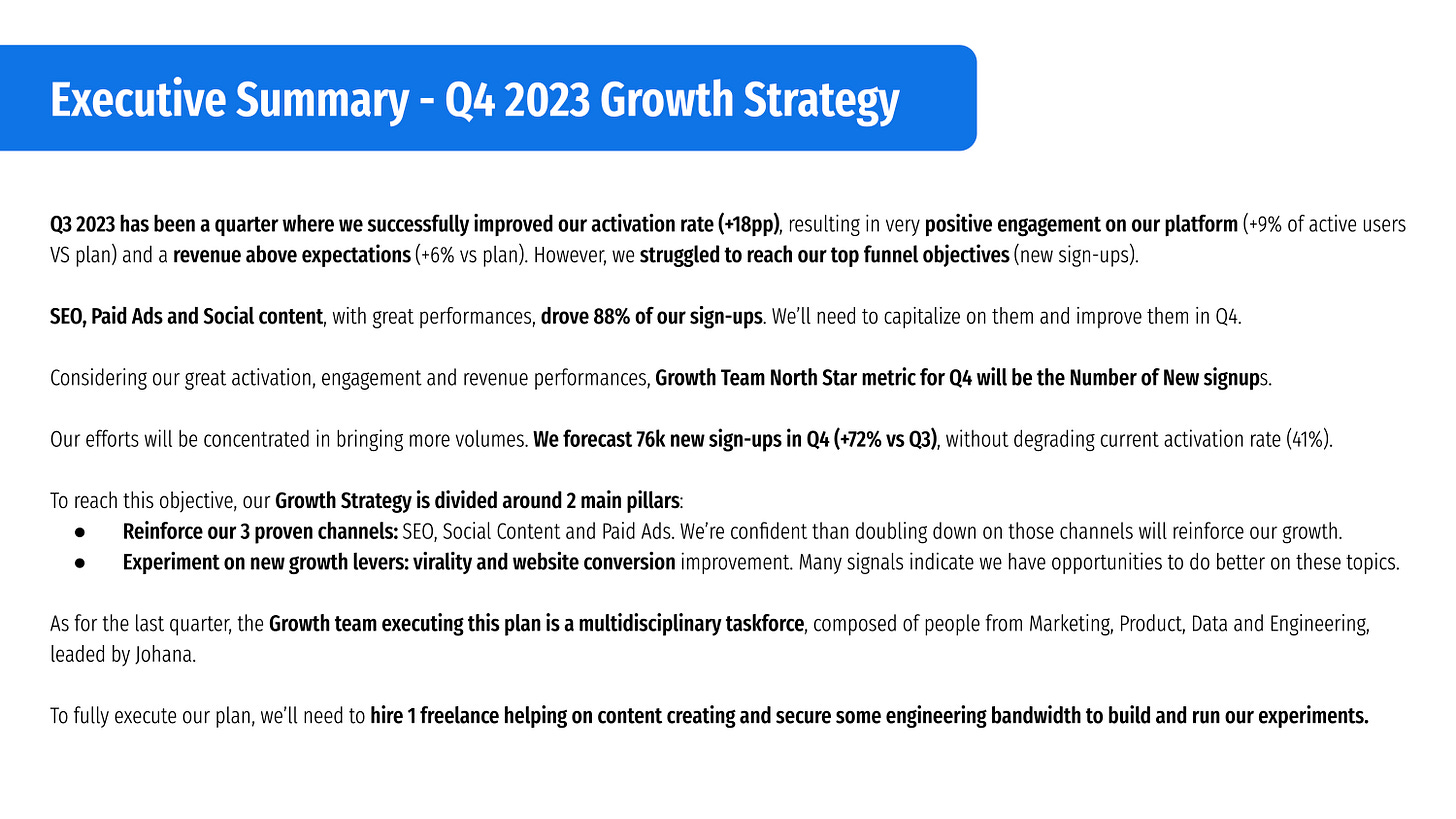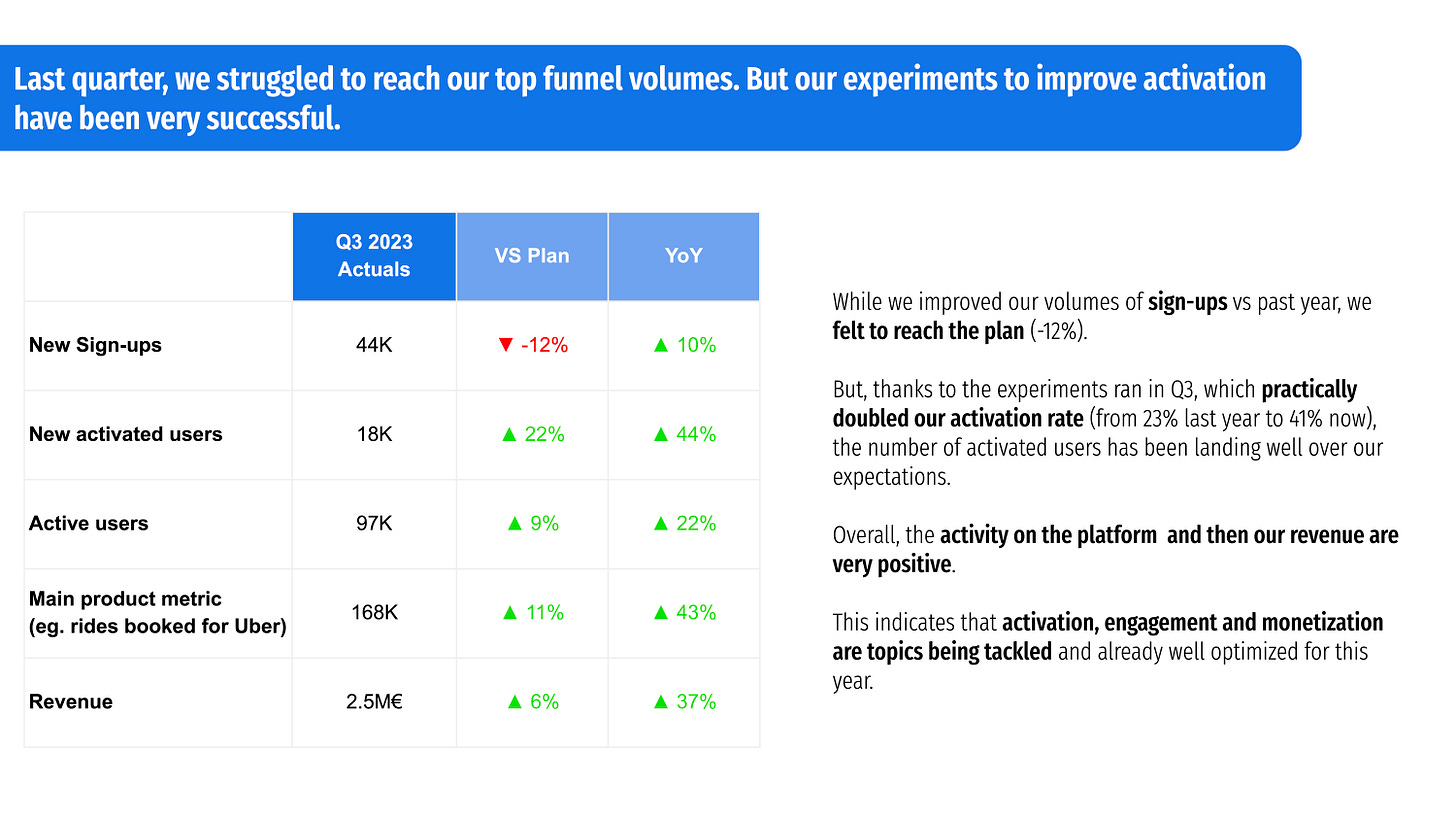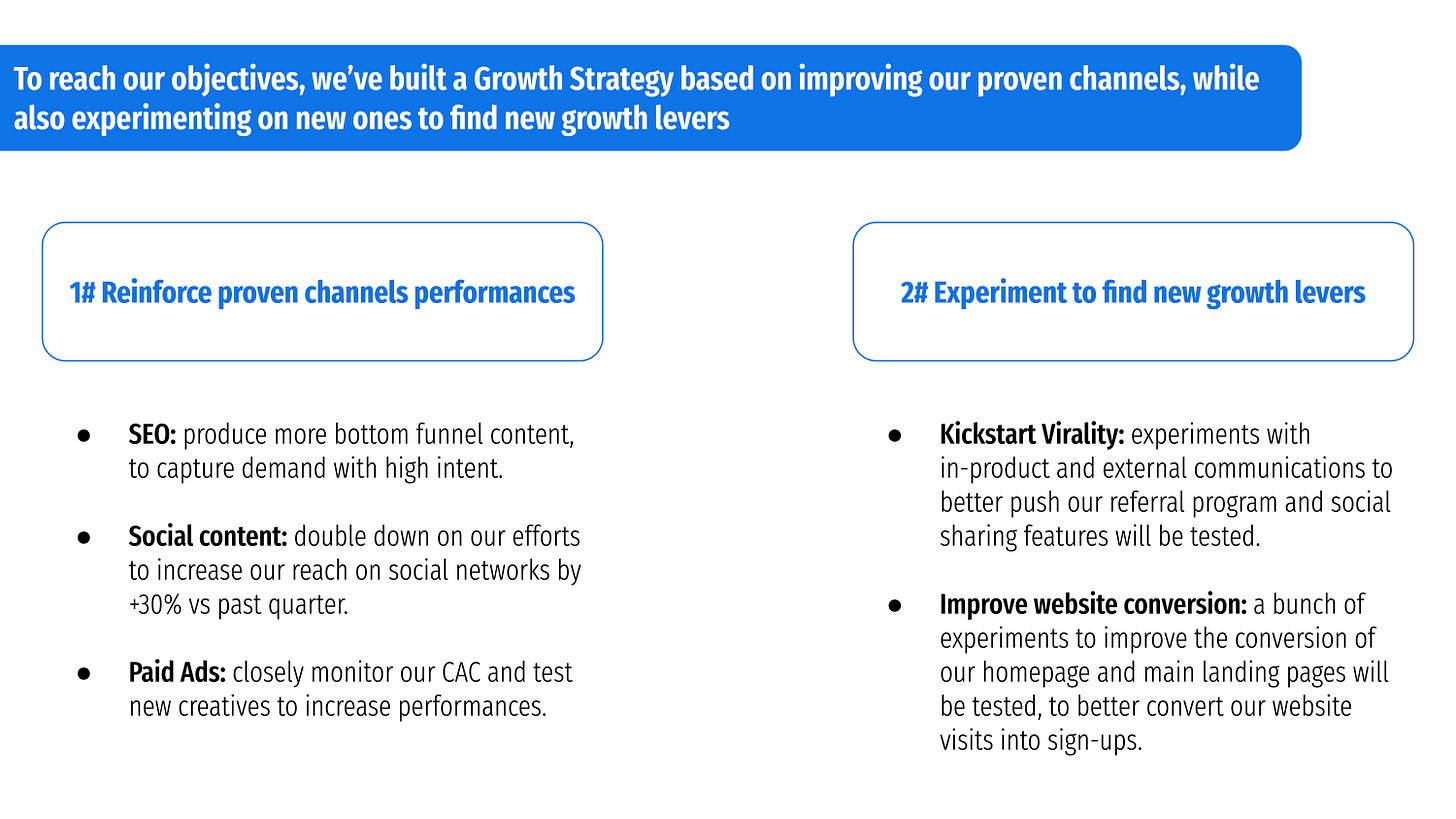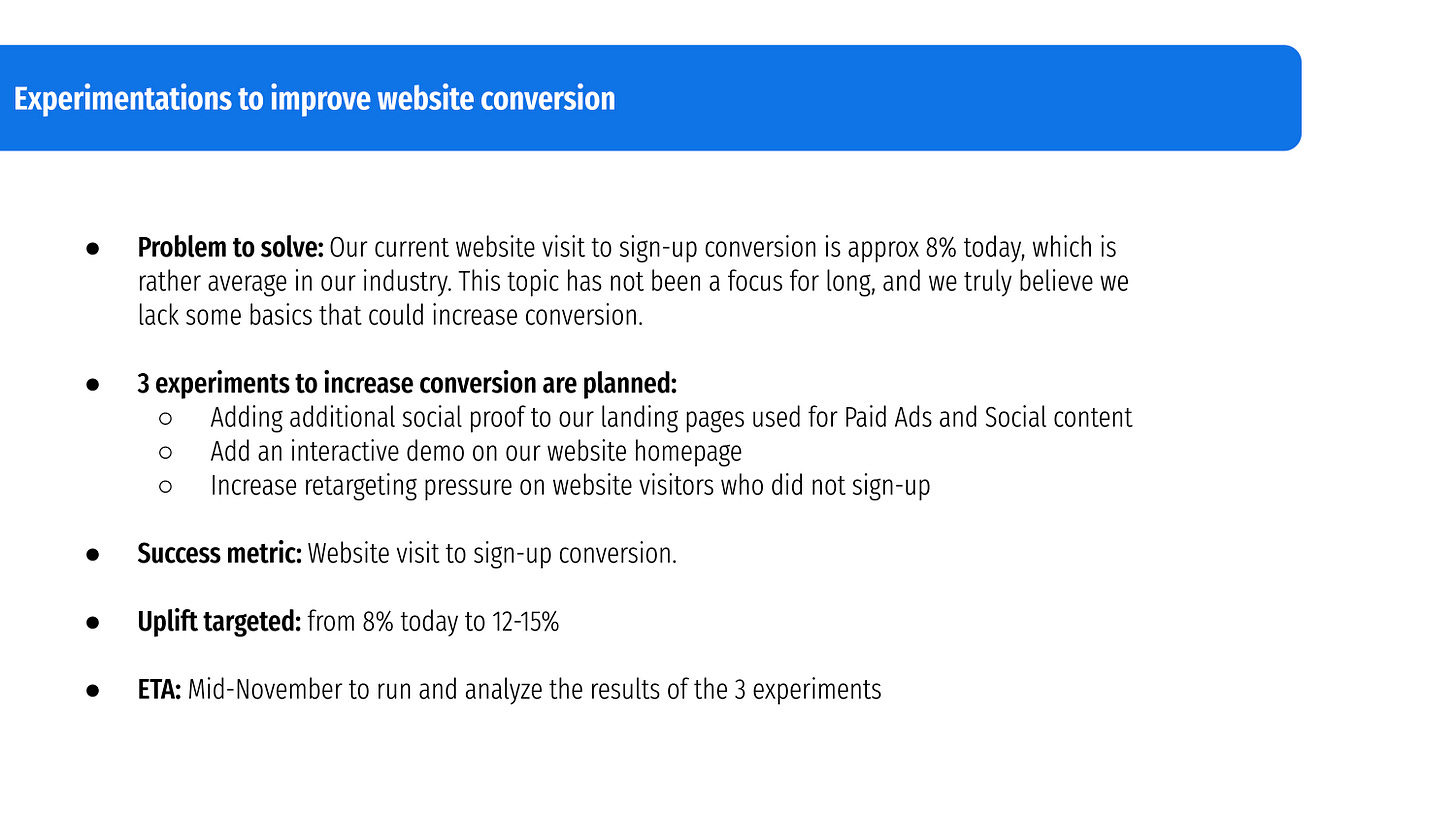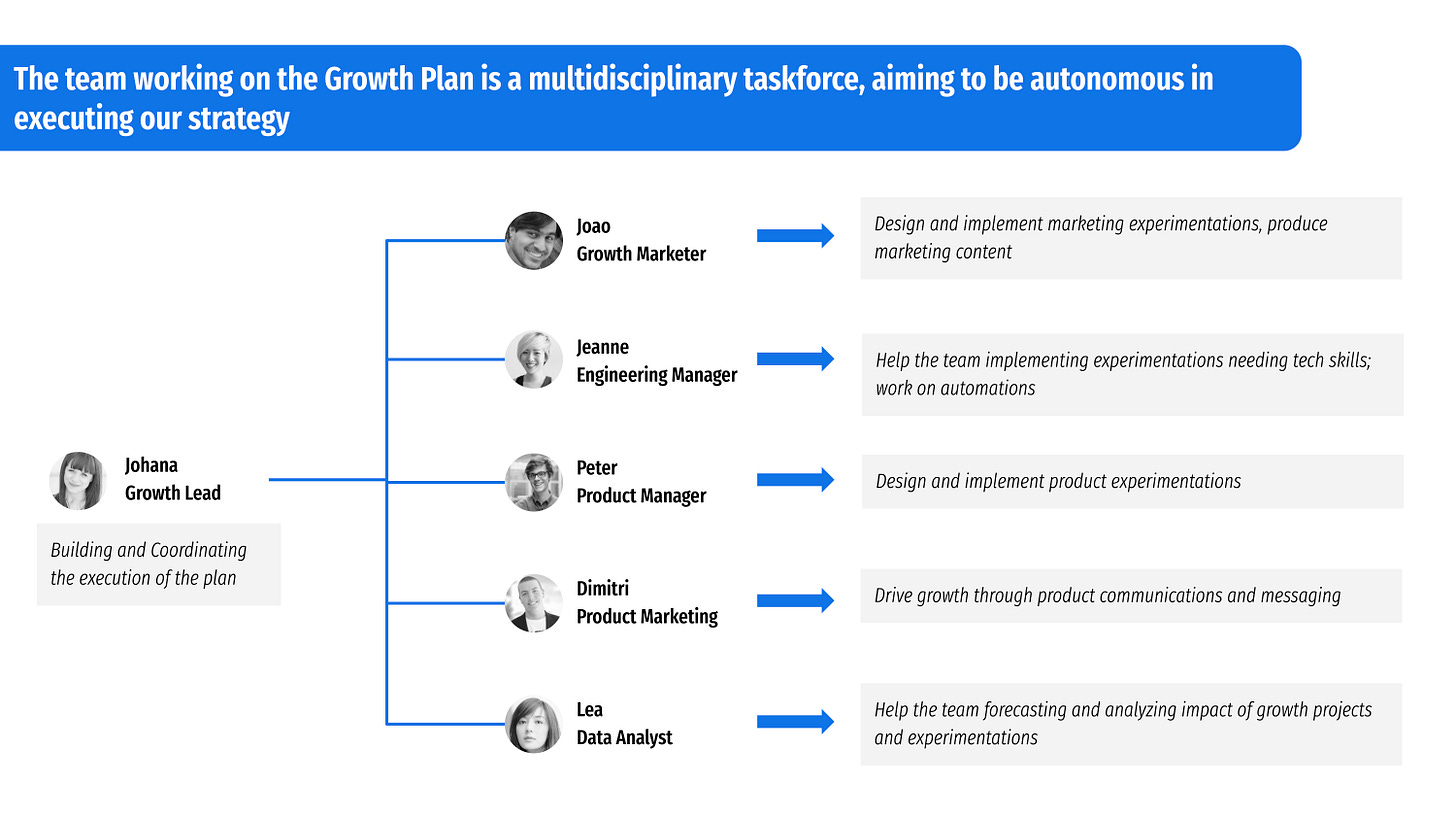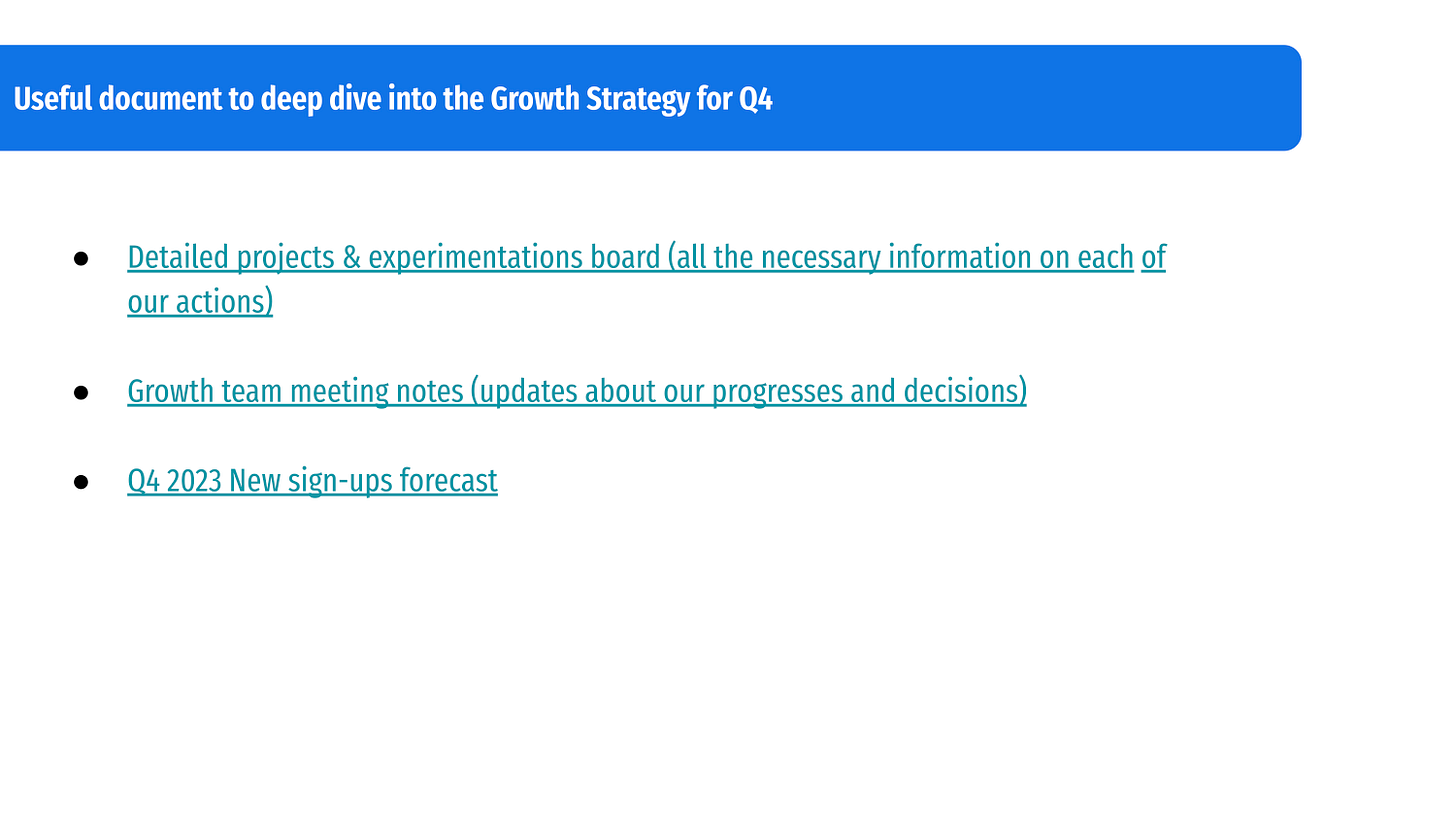A 9 steps playbook to build & present your growth strategy
How to successfully execute your growth plan
👋 Hi there, it’s Pierre-Jean. Welcome to this new edition of The Growth Mind!
Every 2 weeks, I share Growth strategies & reflections, inspired by the world’s leading scale-ups.
If you’re working in Growth and a part of your job consists of building and presenting a growth strategy to your company, this playbook is for you 🫵
Building and presenting your growth strategy internally is key to:
Align your team and other relevant stakeholders of the company on where you should focus your growth efforts.
Get the resources (financial or human) and support from your C-levels to execute your growth strategy.
Without clear alignment and internal support on your strategy, you’ll very likely struggle to deliver your growth plan.
Building and presenting well your growth strategy is then key to making you successful internally.
That’s why I’m sharing this playbook, inspired by many growth strategy presentations I’ve done in the past years; and discussions with peers that succeeded in this exercise.
The playbook to build and present a growth strategy that stands out is divided into 9 sections:
📝 Executive Summary
📈 State of growth of the company
⭐️ North Star metric & KPIs
📊 Objectives & forecast
🚀 High-level growth strategy
🛣️ Detailed tactics & experimentations
⛽️ Resources needed
🙋♂️ Team involved in Growth
🔗 Appendix (optional)
The ultimate playbook to present your growth strategy 📘
A few tips & tricks before starting:
Use the right tools: A simple Notion or Google Slides perfectly does the job. You want something that can handle both your words and visuals with ease.
Make the document visually engaging: Charts, diagrams, and visuals are powerful to illustrate your ideas. Use them as much as possible when relevant.
Keep it simple: Especially when presenting to C-levels. Keep your deck readable, but also robust and on-point.
Use snappy Titles: Instead of classic titles like “Growth Strategy Plan”, go with “Our growth efforts will be on user activation, playing both on marketing & product levers”. See the difference?
Engage Your Audience: Welcome challenges. Involve them in your strategy building. More involvement from stakeholders = more support and commitment.
Include additional information in an appendix: so everyone who wants to deep dive into one of your tactics or experiments details can do it.
1. 📝 Executive summary
This is the first section of your deck, but the one you should build at the end.
The executive summary should be a one/two-pager maximum, summarizing the most essential ideas of your growth strategy.
Its purpose is to make executives (and everyone else) from the company you’re sharing your strategy with quickly understand what’s your Growth plan for the coming months.
Executives receive dozens of decks like yours every month, so making things easier for them would be much appreciated.
Basically, one sentence per section of the playbook will do the job. Make sure to be extremely clear and straightforward.
Example ⬇️
2. 📈 State of growth of the company
In this section, we want to have a clear overview on:
How the company performed during the past quarters in reaching its growth objectives
How your product currently grows
This part of the playbook is an observation of the past, that will help you build your Growth Strategy for the future.
A. How the company performed during the past quarter(s):
This is the starting point to see what we’ve done well during the last period, and then what we’ll try to improve with our growth strategy for the next period.
Select 3-5 metrics that are very important for the company and the Growth team, presented in a table, with the comparison VS your plan and YoY (year over year).
Don’t try to report on all the possible metrics, it will quickly become too complicated.
Example ⬇️
B. How your product currently grows:
Here, we want to visualize the channels and tactics that contribute to growth.
How do you acquire users? What are your main acquisition channels and how do they perform?
How do you activate and retain them?
How do you monetize them?
A simple figure or table, accompanied by text, can explain this. This objective is not to deep dive but to give a reminder of how growth happens in your company and start adding some recommendations.
Depending on the focus of the Growth team, you can choose to focus on a specific part of the user experience.
Example ⬇️
3. ⭐️ North star metric & KPIS
Now that we have a clear understanding of how we performed during the last period, it’s time to see what will be our focus for the upcoming one.
What is the main metric you’re focusing on? This should be highly linked to the North Star of the company (can be the same)
Why do you focus on this metric? Depending on your observations made in the section before, you should have seen things to improve, making it logical to focus on this metric. (eg. if the number of activated users was low but all other metrics were great, it should probably be a good thing to focus on the activation rate).
What are the KPIs you’ll working on? To serve your North Star metric, you have a bunch of KPIs you will try improving. They’re very important to include, as it’s often easier to experiment on very specific KPIs than on a large North Star metric. The sum of improvements on those KPIs is what will contribute to reaching your main objective.
Example ⬇️
️
4. 📊 Objectives & forecast
Once you’ve defined your north star metric, what are your forecast and objectives for the upcoming period for the growth team?
I advise here to include simple graphs or tables, presenting your objectives for the upcoming period. This section will serve as a reference point to assess your performance.
There are generally 2 ways to define your objectives & forecast:
1# Top → Down: Objectives have already been defined by the top management or a strategy team, then you just have to include them.
2# Bottom → Up: You need to build your own objectives and forecast for the team, then it’s key to build a realistic plan, based on what you know will work (marketing/product programs with proven effects) + potential impact of new experiments (new things you’ll test).
Example ⬇️
5. 🚀 High-level growth strategy
Here comes the most important part of the document. Now that we have our metric to focus on and our objectives, it’s time to build our Growth plan.
In this section, you’ll want, with a high-level view, to answer the question: What are the main levers you’re going to activate to reach our objectives?
This section should be a simple one page presenting your Growth Strategy, including:
Levers/channels you’ll play on.
Experiments you’ll run.
Which part of the funnel you’re working on.
I advise here to separate:
The channels already working well, that you’re monitoring and continuously improving.
The new projects and experiments to test, with yet an unknown impact.
Example ⬇️
6. 🛣️ Detailed tactics & experimentations
This section is the continuity of the previous one, but more detailed.
Here you can deep dive into your different tactics & experimentations:
Describe the tactic/experiment
What is the objective and success metric
Which part of the funnel it’s based on
What is the expected impact on your Growth Plan
Which channel do you use to communicate
Example ⬇️ (for one area of experiments only)
7. 🙋♂️ Team involved in Growth
Here, we present the team who’s working on executing the Growth Strategy. Depending on your focus, you might need different profiles.
For executing a growth strategy, you generally need the following profiles:
Growth lead: coordinating the execution of the plan.
Marketer: in charge of top funnel/marketing actions.
Product manager: in charge of implementing product features designed for growth.
Product marketing manager: to communicate efficiently in product.
Engineers: to implement your experimentations.
Data analyst: to analyze the impact of your actions.
This can of course be different, but that’s generally a great organization.
Make sure to clearly define the ownerships, so people in your growth task force know what they need to do to reach your objectives.
Example ⬇️
8. ⛽️ Resources needed
To properly execute your growth strategy, you need resources.
If you need extra support, then it’s time to ask for it.
I include this section at the end of the Growth Strategy playbook because it’s key to have a clear strategy and vision before asking for resources.
When asking for resources, be clear on:
What type of resources do you need? Financial (more budget) or human (an FTE, freelance, or bandwidth from another team)?
Why do you need those resources? What is at stake if you don’t have them? For example, it can be impossible to test a new tactic without an extra budget or the help of a team.
What is the cost of those resources? The cost can be financial, but also a human (bandwidth from another team).
Prioritize your needs, because you’ll likely not get everything you want. In start-ups, there are often many trade-offs. Your projects are competing with projects from other teams when it comes to allocating resources.
Example ⬇️
9. 🔗 Appendix (optional)
Finally, the appendix section can be used to include any other information you did not add before.
It could be useful data, other documents explaining some growth projects… Anything that can add value to your Growth Strategy presentation.
I generally like to add some documents in the appendix, because I want to be exhaustive when sharing my growth strategy internally. Having an appendix section helps you do it, without having to add too much information to your plan.
Example ⬇️
You now have all the keys to present your Growth Strategy. Hope this playbook will help you 🚀
If you’d like to share feedback on it, feel free to reach out to me or comment directly the article.
See you in 2 weeks for the next edition of The Growth Mind 👋





